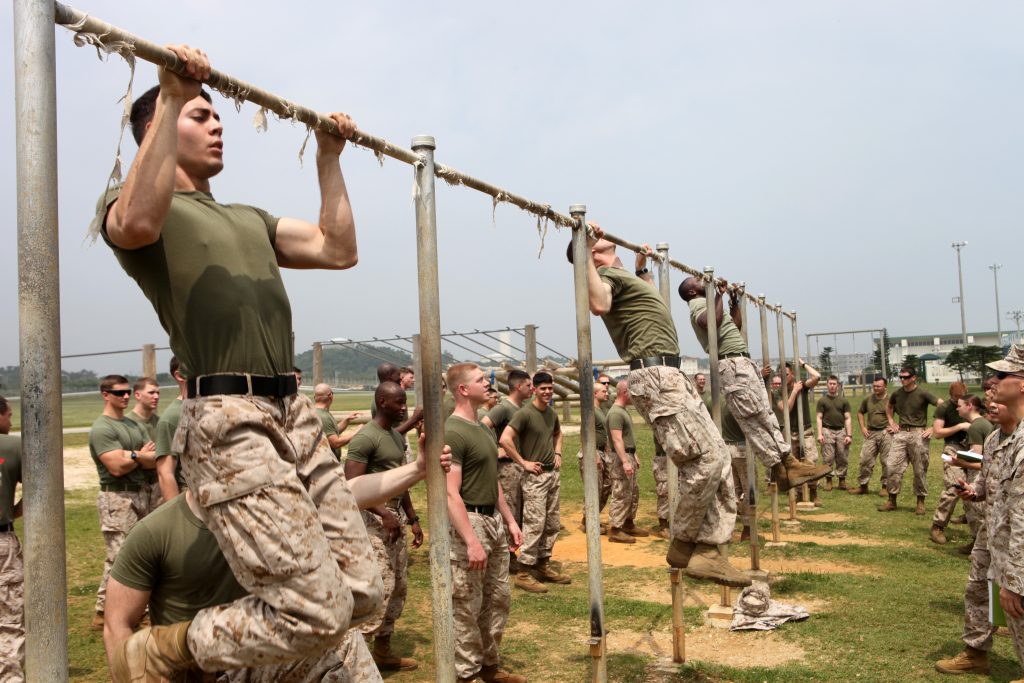Military Fitness: Getting Your First Pull-Up

A line of marines doing pull-ups, strengthening their backs for the jobs ahead of them.
The pull-up is one of the oldest exercises in the book. Since man has had a tree to climb, man has had the ability to vertically pull his own bodyweight, and that ability has since been diluted down the family tree leading to your sorry ass.
So you’re telling me that you can’t even do one lousy pull-up to save your life? Congratulations, you’re Private Pyle, not a good look. But that’s okay, because I used to be just like you. I couldn’t even do one pull-up in front of a marine recruiter that came to my high school, so I understand the feeling. But I worked on it, it took me a while, but I managed to get very good at doing pull-ups, and so can you. The process took a long time for me, because I didn’t understand how to progress. But fear not, I write this article because I’ve learned a bit about programming, and I pass that knowledge onto you so you don’t have to waste as much time as I did. But first…
Why?
So why should we train the pull-up? Well, that answer will vary from person-to-person. Maybe you want to join the Marines where you must be able to perform 3 bodyweight pull-ups in order to even ship out to boot camp. Maybe you rock climb, a sport that requires a monstrous amount of back strength, as well as being able to skillfully pull yourself up a wall. Or maybe you’re just a typical dude who wants to have that sick V-taper so you can pick up chicks at the beach, bro.

“Come fly away with me baby, I’ve got wings for days.” – Bruce Lee, probably…
At the end of the day you want to work your back, and maybe you want some sport-specific benefit that you wouldn’t get from doing barbell rows, in which case, you should be doing pull-ups. The act of pulling yourself up to a bar works your back just as well as, if not better than, any other non-barbell exercise; however, there still could be some confusion as to which kind of pull-up you’re going to do.
First, we must explicitly state the reason why we choose to do any exercise over another. When performing an exercise, we want to use the most amount of muscle mass across an effective range of motion. This approach to training allows us to move the most amount of weight, and save time in the gym by not forcing us to do forty different isolation exercises. There are two common types of pull-ups that can be performed on a normal bar, the chin-up (palms facing you), and the pull-up (palms facing away from you). Both movements stimulate the back muscles in a similar way; however, chin-ups stimulate the biceps to a greater extent. For this reason, when training to get stronger at the movement, I recommend that the individual perform chin-ups rather than pull-ups.
Quick note: for reasons I mentioned in the previous paragraph, you strength between pull-ups and chin-ups transfer. If you manage to increase your strength in the chin-up, your strength in the pull-up will also increase. So don’t worry so much if you’re being tested on the pull-up five months from now. Just make your chin-up stronger, then do more pull-ups as you approach the testing date.
There Is a Point in Which You Can Start, and Progress
In order to talk about programming the chin-up, you must first understand the method in which humans build muscle and get stronger. In order to get stronger, we must use a method called “Progressive Overload”, developed by Dr. Thomas Delorme while rehabilitating injured soldiers after World War II. It is a method in which we progress by continuously (and linearly) overload the muscles such that they recover and adapt to the training stress, thus becoming bigger and stronger. In order to get stronger, you must do enough volume (number of repetitions) at an appropriate intensity (a percentage of the weight of your one-rep-max), in order to force an adaptation from your muscles.
Just from going about your daily life, your body has achieved some baseline level of strength, and your back can produce a certain amount of force, which can then pull a certain amount of weight. That is the weight we start with; however, there is a problem. For some, the amount of weight their back can pull up to the bar is less than their own bodyweight. These people cannot do a single chin-up, and this is an issue. This is a problem because people who cannot do a single chin-up are unable to do enough volume to stimulate an adaptation; and therefore, cannot get stronger. So where do you start?
There are two options that I would recommend, both of which involve you moving less than your bodyweight.
The Lat Pulldown
The lat pulldown is a pretty simple, but incredibly useful machine. Instead of pulling your body up to the bar, you are pulling the bar down to your body. This may not sound like a huge difference, but it is. This means that you can load the bar with whatever weight you can handle, as opposed to being stuck with your own bodyweight. The Lat Pulldown is to be performed with “chin-up style” reps, the protocol of which can be found in the next section.
The Banded Chin-Up
This exercise should be pretty simple to understand. You attach an exercise band to the chin-up bar, stretch the band down enough so you can get your feet in it while your knees and hips are fully extended. This exercise allows you to perform a normal chin-up, but with the band assisting your movement up towards the bar. I prefer this exercise over the lat pulldown because it is more specific to the chin-up (i.e. more similar to the standard chin-up), and the rep gets harder as you approach the top due to the band becoming less stretched, and thus aiding you less, and allowing you to work with heavier weight at the easier portion of the rep.
Banded chin-ups are to be performed the same way that you would perform normal chin-ups. Palms facing you, hands just outside of shoulder width apart, chest up, knees and hips remain locked out (don’t kip, asshole), bar pulled down to the point where it touches your chest, then returned to a complete lockout of the elbows (contrary to what was said in the lat pulldown video), at a controlled pace for one full repetition.
There is a downside to this exercise, you have to buy the bands, but it is absolutely worth it. Buy a band that allows you do 4-5 solid reps with decent effort (i.e. you could do one or two more if you pushed as hard as you can), the thickness of the one you get will vary from person to person. This is the brand that I use.
Programming the Chin-Up
Ideally, you’d be doing chin-ups in addition to barbell training, but the program should work regardless. Fear not, the programming for getting your first real chin-up is incredibly simple.
For those of you that attend gyms and already barbell training, I would recommend training the chin-up twice weekly with at least 2 days in between sessions. On both days, I would recommend you attempt a chin-up, then follow it up with 4 sets of banded chin-ups for 4-8 reps. I don’t recommend you go all out for the first three sets of chin-ups, leave one or two in the tank, but the last set can be a full max effort attempt. Increase the number of reps you do in each set over the weeks, and move to a thinner band when appropriate. If you can do 8 reps across the first 3 sets, then more than 8 on the last one, you need a thinner band. Rest 2-3 minutes in between sets. This same set/rep scheme can be used on the lat pulldown, and you can adjust the weight accordingly. By the time you get to a very thin band, or close to your bodyweight in the lat pulldown, you should be able to do at least one chin-up. Once you can do more than three chin-ups, the programming will have to change to reflect the increase in strength.
An example of the program might look something like this:
Week 1:
- Day 1 – Chin-up attempt, Purple Band Chin-Up x (4,4,4,3) reps
- Day 2 – Chin-up attempt, Lat Pulldown 120lbs x (5,5,4,5) reps
Week 2:
- Day 1 – Chin-up attempt, Purple Band Chin-Up x (5,5, 5,6)
- Day 2 – Chin-up attempt, Lat Pulldown 120lbs x (7,7,6,6)
Week 3:
- Day 1 – Chin-up attempt, Purple Band Chin-Up x (7,6,6,6)
- Day 2 – Chin-up attempt, Lat Pulldown 120lbs x (8,8,8,9)
Week 4:
- Day 1 – Chin-up attempt, Purple Band Chin-Up x (8,8,8,9)
- Day 2 – Chin-up attempt, Lat Pulldown 140lbs x (5,5,4,3)
Week 5:
- Day 1 – Chin-up attempt, Black Band Chin-Up x (5,4,4,4)
- Day 2 – Chin-up attempt, Lat Pulldown 140lbs x (7,6,5,5)
Week 5:
- Day 1 – Chin-up attempt, Black Band Chin-Up x (8,6,6,7)
- Day 2 – Chin-up attempt, Lat Pulldown 140lbs x (8,8,8,9)
Week 6:
- Day 1 – Successful Chin-up attempt! Black Band Chin-Up x (8,8,8,10)
- Day 2 – Successful Chin-up attempt! Lat Pulldown 160lbs x (4,4,3,3)
Week 7 (From here, you can start to attempt as many chin-ups as possible for max effort before your volume work):
- Day 1 – Chin-Up x 1, Red Band Chin-Up x (5,4,4,2)
- Day 2 – Chin-Up x 2, Lat Pulldown 160lbs x (7,5,4,4)
Week 8:
- Day 1 – Chin-Up x 3, Red Band Chin-Up x (5,5,5,5)
- Day 2 – Chin-Up x 4, Lat Pulldown 160lbs x (8,8,7,8)
Obviously this program is just an example, and the rate of your progression may differ, but you should be progressing every week. Once you are able to do more than three chin-ups, you should attempt a set of overhand pull-ups for as many reps as possible, you should be able to do roughly the same amount.
There you have it, a simple but effective program to get you your first chin-up and/or pull-up, then a couple more. Now get out there and train your ass off!




